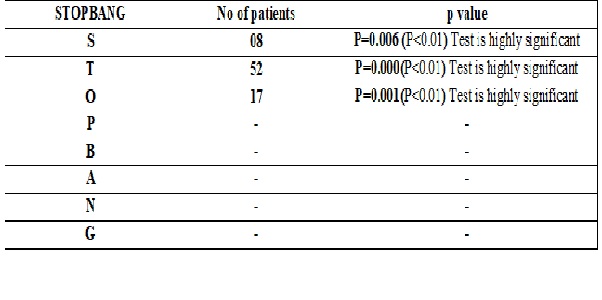Observational study to determine the pattern of distribution of stop - bang score in predicting OSA and its implication among female health care providers
Abstract
Objective: To determine the pattern of distribution of STOP-Bang score in predicting OSA and its implication among female health care providers.
Methods: In this study, we enrolled 100 female health care providers with age>20 years and excluded subjects on long term respiratory illness and with secondary cause of obesity. Detailed historyand clinical examination were done along withfilled STOP-Bang questionnaire.
Results: We included 100 subjects, the mean age was 26.23 ± 1.74 years, mean BMI was 23.18+ 1.73. Our study results, Snoring, Tiredness and observed apnea were observed more than other parameters. In the study, the significance of snoring (8% with ‘p’ value 0.006), tiredness (52% with ‘p’ value 0.000) and observed apnea (17% with ‘p’ value 0.001) was statistically significant.The most common score on the STOP-Bang questionnaire was 1point (n = 42), followed by no points (n = 41). Subjects with low risk were 57; with high risk were 2 which were statistically significant.
Conclusion: Snoring, tiredness and observed apnea play an important factor among females in STOP-Bang score which also was statistically significant.The STOP-Bang questionnaire performed adequately for OSA screening in female health care providersindicated that it could be used as an effective non-invasive screening tool for identifying subjects with high risk of OSA.
Downloads
References
Young T, Hutton R, Finn L, et al. The gender bias in sleep apnea diagnosis. Are women missed because they have different symptoms? Arch Intern Med. 1996 Nov 25;156(21):2445-51.
Lettieri CJ, Eliasson AH, Andrada T, et al. Obstructive sleep apnea syndrome: are we missing an at-risk population? J Clin Sleep Med. 2005 Oct 15;1(4):381-5.
Young T, Finn L, Peppard PE, et al. Sleep disordered breathing and mortality: eighteen-year follow-up of the Wisconsin sleep cohort. Sleep. 2008 Aug;31(8):1071-8.
Ancoli-Israel S, Kripke DF, Klauber MR, et al. Sleep-disordered breathing in community-dwelling elderly. Sleep. 1991 Dec;14(6):486-95.
Vasu TS, Grewal R, Doghramji K. et al. Obstructive sleep apnea syndrome and perioperative complications: a systematic review of the literature. J Clin Sleep Med. 2012 Apr 15;8(2):199-207. doi: https://doi.org/10.5664/jcsm.1784.
Chung F, Yegneswaran B, Liao P, et al. STOP questionnaire: a tool to screen patients for obstructive sleep apnea. Anesthesiology. 2008 May;108(5):812-21. doi: https://doi.org/10.1097/ALN.0b013e31816d83e4.
Eckel RH, Krauss RM. American Heart Association call to action: obesity as a major risk factor for coronary heart disease. AHA Nutrition Committee. Circulation. 1998 Jun 2;97(21):2099-100.
Wolf AM, Colditz GA. The cost of obesity: the US perspective. Pharmacoeconomics. 1994;5(Suppl 1):34-7. DOI: https://doi.org/10.2165/00019053-199400051-00007.
Wolf AM, Colditz GA. Current estimates of the economic cost of obesity in the United States. Obes Res. 1998 Mar;6(2):97-106.
James PT, Leach R, Kalamara E, et al. The worldwide obesity epidemic. Obes Res. 2001 Nov;9 Suppl 4:228S-233S.
World Health Organization. Obesity: Preventing and Managing the Global Epidemic. Report of a WHO consultation of obesity.WHO, Geneva, 3–5 June 1977.
Farney RJ, Walker BS, Farney RM, et al. The STOP-Bang equivalent model and prediction of severity of obstructive sleep apnea: relation to polysomnographic measurements of the apnea/hypopnea index. J Clin Sleep Med. 2011 Oct 15;7(5):459-65B. doi: https://doi.org/10.5664/JCSM.1306.
Luo J, Huang R, Zhong X, et al. STOP-Bang questionnaire is superior to Epworth sleepiness scales, Berlin questionnaire, and STOP questionnaire in screening obstructive sleep apnea hypopnea syndrome patients. Chin Med J (Engl). 2014;127(17):3065-70.
Guralnick AS, Pant M, Minhaj M, et al. CPAP adherence in patients with newly diagnosed obstructive sleep apnea prior to elective surgery. J Clin Sleep Med. 2012 Oct 15;8(5):501-6. doi: https://doi.org/10.5664/jcsm.2140.
Nagappa M, Liao P, Wong J, et al. Validation of the STOP-Bang Questionnaire as a Screening Tool for Obstructive Sleep Apnea among Different Populations: A Systematic Review and Meta-Analysis. PLoS One. 2015 Dec 14;10(12):e0143697. doi: https://doi.org/10.1371/journal.pone.0143697. eCollection 2015.
Silva GE, Vana KD, Goodwin JL, et al. Identification of patients with sleep disordered breathing: comparing the four-variable screening tool, STOP, STOP-Bang, and Epworth Sleepiness Scales. J Clin Sleep Med. 2011 Oct 15;7(5):467-72. doi: https://doi.org/10.5664/JCSM.1308.
Chung F, Yang Y, Liao P. Predictive performance of the STOP-Bang score for identifying obstructive sleep apnea in obese patients. Obes Surg. 2013 Dec;23(12):2050-7. doi: https://doi.org/10.1007/s11695-013-1006-z.
Vasu TS, Doghramji K, Cavallazzi R, et al. Obstructive sleep apnea syndrome and postoperative complications: clinical use of the STOP-BANG questionnaire. Arch Otolaryngol Head Neck Surg. 2010 Oct;136(10):1020-4. doi: https://doi.org/10.1001/archoto.2010.1020.
Corso RM, Petrini F, Buccioli M, et al. Clinical utility of preoperative screening with STOP-Bang questionnaire in elective surgery. Minerva Anestesiol. 2014 Aug;80(8):877-84. Epub 2013 Nov 26.
Dancey DR, Hanly PJ, Soong C, et al. Gender differences in sleep apnea: the role of neck circumference. Chest. 2003 May;123(5):1544-50.
Ricardo Luiz de Menezes Duarte, Lorena Barbosa de Moraes Fonseca, Flavio José Magalhães-da-Silveira1, Erika Aparecida da Silveira, Marcelo Fouad Rabahi et al; J Bras Pneumol. 2017;43(6):456-463; Validation of the STOP-Bang questionnaire as a means of screening for obstructive sleep apnea in adults in Brazil.
C Pena Orbea, R M Lloyd, E Kapoor, V M Miller, K Mara, S Faubion ; predictive ability and reliability of the STOP-Bang Questionnaire in screening for OSA in midlife women: sleep, volume 41, April 2018- pages A189.
Nagappa M, Liao P, Wong J, et al. Validation of the STOP-Bang Questionnaire as a Screening Tool for Obstructive Sleep Apnea among Different Populations: A Systematic Review and Meta-Analysis. PLoS One. 2015 Dec 14;10(12):e0143697. doi: https://doi.org/10.1371/journal.pone.0143697. eCollection 2015.



 OAI - Open Archives Initiative
OAI - Open Archives Initiative


